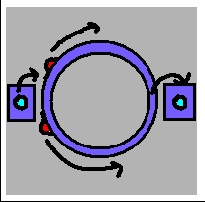Smitha Vishveshwara
 Fractionalization in Strongly Interacting Quantum Systems
Fractionalization in Strongly Interacting Quantum Systems
One of the most spectacular predictions regarding collective behavior in quantum systems in one and two dimensions is the existence of fractional quasiparticles whose quantum mechanical properties can be vastly different from those of the individuals comprising the system. Professor Vishveshwara’s research broadly aims to detect and manipulate such quasiparticles. During her Center appointment, she will address related issues and execute two ideas to study correlations between quasiparticles and their dynamics in novel geometries:
- Fractional charge on a ring. Professor Vishveshwara envisions the setting where an electron plunges from one lead into a strongly correlated ring-shaped etched structure and plunges out of it onto another lead (Fig. 1). Having lost its identity within the ring, how does the electron retrieve it again when it emerges out of the system? Does the electron fractionalize? If so, which piece of the electron propagates in which direction around the ring? What does the act of measurement actually mean in this situation? The aim is to answer these questions in a precise fashion by evaluating measurable quantities under different conditions, such as the current across the two leads in the presence of a voltage drop or a magnetic field through the ring.
- Anyons in a saddle potential. Here, Professor Vishveshwara and her collaborators have conceived of anyons–quasiparticles whose quantum statistical properties are completely different from those of the fundamental particles found in nature–in the presence of a saddle potential, akin to the saddle formed between two hills. Two anyons, each placed at the apex of one of these hills, roll toward the saddle and then off toward the sides (Fig. 2). Whether they roll off on the same side, opposite sides, or part of both depends on their “fractional” statistics and associated bunching or repelling tendencies.
Results from these theoretical investigations and proposals for experiment will throw light on fundamental features of fractional quasiparticles and also potentially open the way to connections with quantum computational schemes. Professor Vishveshwara plans to present the results at international conferences and work hand-in-hand with experimentalists to implement the results.
